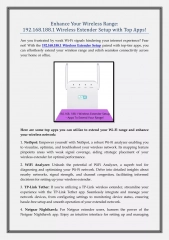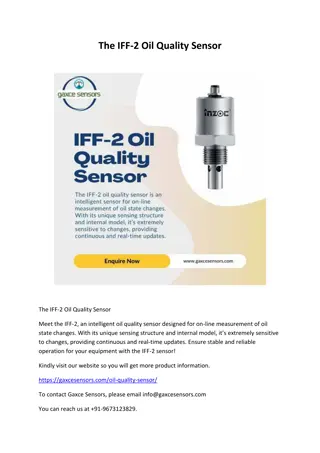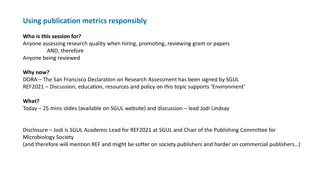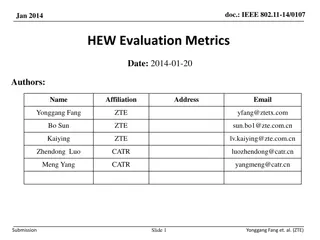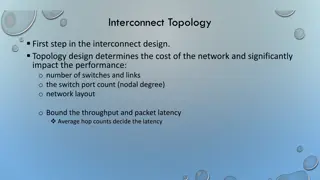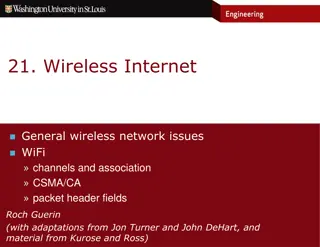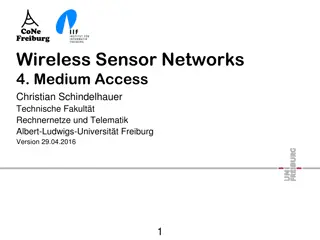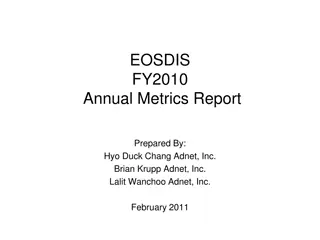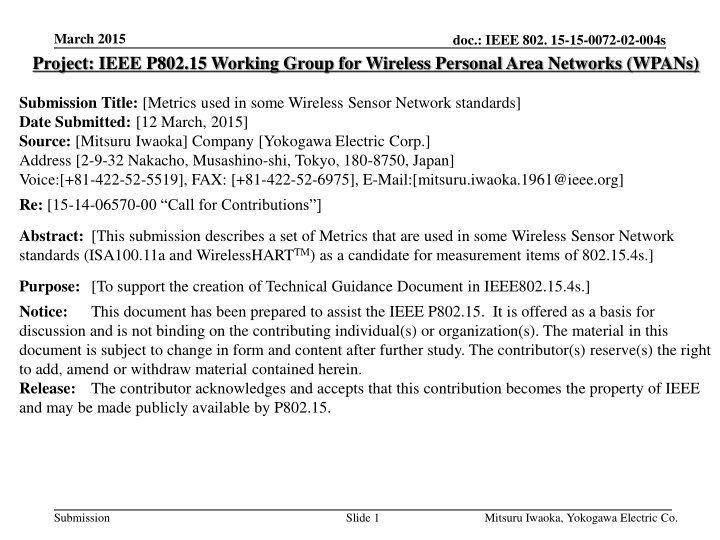
Metrics Used in Wireless Sensor Network Standards
"Learn about the metrics used in Wireless Sensor Network standards like ISA100.11a and WirelessHARTTM for network health monitoring, link health monitoring, and device health monitoring. Explore a comprehensive set of metrics including network latency, packet transmission, reception, security, and more to support IEEE802.15.4s development."
Download Presentation

Please find below an Image/Link to download the presentation.
The content on the website is provided AS IS for your information and personal use only. It may not be sold, licensed, or shared on other websites without obtaining consent from the author. If you encounter any issues during the download, it is possible that the publisher has removed the file from their server.
You are allowed to download the files provided on this website for personal or commercial use, subject to the condition that they are used lawfully. All files are the property of their respective owners.
The content on the website is provided AS IS for your information and personal use only. It may not be sold, licensed, or shared on other websites without obtaining consent from the author.
E N D
Presentation Transcript
March 2015 Project: IEEE P802.15 Working Group for Wireless Personal Area Networks (WPANs) doc.: IEEE 802. 15-15-0072-02-004s Submission Title: [Metrics used in some Wireless Sensor Network standards] Date Submitted: [12 March, 2015] Source: [Mitsuru Iwaoka] Company [Yokogawa Electric Corp.] Address [2-9-32 Nakacho, Musashino-shi, Tokyo, 180-8750, Japan] Voice:[+81-422-52-5519], FAX: [+81-422-52-6975], E-Mail:[mitsuru.iwaoka.1961@ieee.org] Re: [15-14-06570-00 Call for Contributions ] Abstract: [This submission describes a set of Metrics that are used in some Wireless Sensor Network standards (ISA100.11a and WirelessHARTTM) as a candidate for measurement items of 802.15.4s.] Purpose: [To support the creation of Technical Guidance Document in IEEE802.15.4s.] Notice: This document has been prepared to assist the IEEE P802.15. It is offered as a basis for discussion and is not binding on the contributing individual(s) or organization(s). The material in this document is subject to change in form and content after further study. The contributor(s) reserve(s) the right to add, amend or withdraw material contained herein. Release: The contributor acknowledges and accepts that this contribution becomes the property of IEEE and may be made publicly available by P802.15. Submission Slide 1 Mitsuru Iwaoka, Yokogawa Electric Co.
March 2015 doc.: IEEE 802. 15-15-0072-02-004s Metrics used in some Wireless Sensor Network standards Mitsuru Iwaoka Shusaku Shimada R2: Correct measurement table Submission Slide 2 Mitsuru Iwaoka, Yokogawa Electric Co.
March 2015 doc.: IEEE 802. 15-15-0072-02-004s Preface Some Wireless Sensor Network (WSN) standards (ISA100.11a and WirelessHARTTM) provide a set of metrics for: Network health monitoring Link health monitoring Device health monitoring Some of these metrics are also useful for other 802.15.4 based networks. 802.15.4s SRU should support a subset of these metrics. Submission Slide 3 Mitsuru Iwaoka, Yokogawa Electric Co.
March 2015 doc.: IEEE 802. 15-15-0072-02-004s Summary of Metrics Metrics Network Link Ch. Device Number of joins to the network Latency Number of packets transmitted Number of packets received Number of failed transmission (No Ack) Percentage of time of failed transmissions (No Ack) Number of deferred transmission (CCA) Percentage of time of deferred transmissions (CCA) Number of failed reception (CRC error) Received signal level (RSSI) Received signal quality indicator (RSQI) Average / Maximum Buffer Utilization Security Submission Slide 4 Mitsuru Iwaoka, Yokogawa Electric Co.
March 2015 doc.: IEEE 802. 15-15-0072-02-004s Metric: Throughput Throughput is not directly measured Number of successfully transmitted packets are measured periodically. Throughput is estimated by Num. of successfully Tx packets / interval Submission Slide 5 Mitsuru Iwaoka, Yokogawa Electric Co.
March 2015 doc.: IEEE 802. 15-15-0072-02-004s Metric: Latency Two types of latency metric are used: The percentage of scheduled packets that arrive later than expected. These packets may be delayed due to delivery over secondary paths or due to congestion in intermediate devices. Latency is computed from the packet timestamp and the time of packet reception Each packet receives a timestamp when it is put in the transmit buffer Standard deviation of latency (jitter) is also computed Time synchronization is necessary (e.g. TSCH) Submission Slide 6 Mitsuru Iwaoka, Yokogawa Electric Co.
March 2015 doc.: IEEE 802. 15-15-0072-02-004s Metric: Security Link level MIC error counter Network level MIC error counter Network level failed join counter Submission Slide 7 Mitsuru Iwaoka, Yokogawa Electric Co.
March 2015 doc.: IEEE 802. 15-15-0072-02-004s Metric: RSSI/RSQI RSSI is reported as a signed 8-bit integer, reflecting an estimate of received signal strength in dBm. RSSI reports may be biased by +64 dBm to give an effective range of -192 dBm to +63 dBm. RSQI is reported as a qualitative assessment of signal quality, with higher number indicating a better signal. 1..63 indicates a poor signal 64..127 a fair signal 128..191 a good signal 192..255 an excellent signal. 0 indicates that the chipset does not support any signal quality diagnostics other than RSSI. Submission Slide 8 Mitsuru Iwaoka, Yokogawa Electric Co.
March 2015 doc.: IEEE 802. 15-15-0072-02-004s Network / Link / Device A gateway accumulate measurement of each link to calculate network level metrics. Each device provides link level and channel level measurements of metrics. Propose to support Link and channel level metrics in 802.15.4s. Submission Slide 9 Mitsuru Iwaoka, Yokogawa Electric Co.

